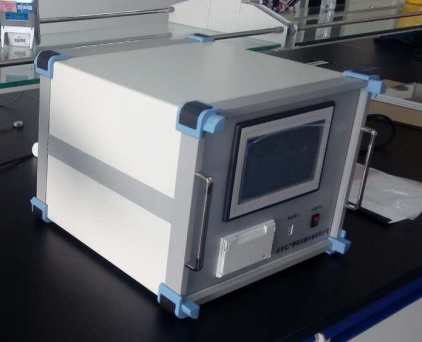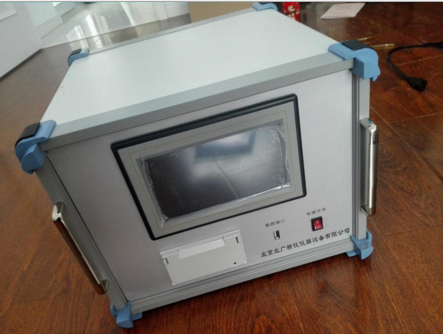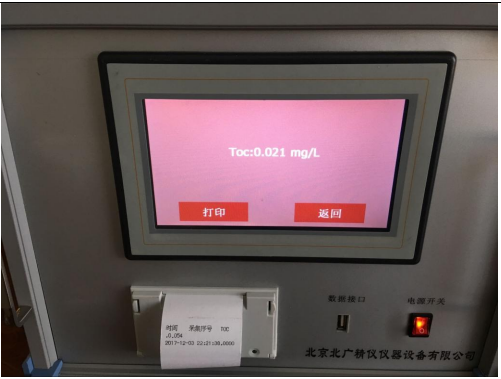
價(jià)格:38450元瀏覽:100次聯(lián)系:劉元元 / 15132636097 / 企業(yè):北京北廣精儀儀器設(shè)備有限公司留言店鋪收藏
純水總有機(jī)碳(TOC)分析儀 水樣中TOC的分析步驟
水中的有機(jī)物質(zhì)的含量,以有機(jī)物中的主要元素一碳的量來表示,稱為總有機(jī)碳。TOC的測(cè)定類似于TOD的測(cè)定。在950℃的高溫下,使水樣中的有機(jī)物氣化燃燒,生成CO2,通過紅外線分析儀,測(cè)定其生成的CO2之量,即可知總有機(jī)碳量。
純水總有機(jī)碳(TOC)分析儀 水中TOC的監(jiān)測(cè)
我們的生活離不開水,若相當(dāng)多的有機(jī)污染物存在于水中,將直接影響水體的質(zhì)量,對(duì)我們的生活和生產(chǎn)造成危害,因此水和廢水的監(jiān)測(cè),越來越引起人們的重視。其中水體中總有機(jī)碳(TOC)含量的檢測(cè),日益引起關(guān)注。它是以碳含量表示水體中有機(jī)物質(zhì)總量的綜合指標(biāo)。TOC的測(cè)定一般采用燃燒法,此法能將水樣中有機(jī)物全部氧化,可以很直接地用來表示有機(jī)物的總量。因而它被作為評(píng)價(jià)水體中有機(jī)物污染程度的一項(xiàng)重要參考指標(biāo)。
測(cè)定原理
總有機(jī)碳(TOC),由專門的儀器——總有機(jī)碳分析儀(以下簡(jiǎn)稱TOC分析儀)來測(cè)定。TOC分析儀,是將水溶液中的總有機(jī)碳氧化為二氧化碳,并且測(cè)定其含量。利用二氧化碳與總有機(jī)碳之間碳含量的對(duì)應(yīng)關(guān)系,從而對(duì)水溶液中總有機(jī)碳進(jìn)行定量測(cè)定。
市面上常見的TOC分析儀都有兩大基本功能:第一,首先將水中的總有機(jī)碳充分氧化,生成二氧化碳CO2;第二,測(cè)試新產(chǎn)生的CO2.不同品牌和型號(hào)的TOC分析儀的區(qū)別在于實(shí)現(xiàn)這兩大基本功能的方法不同。常用的氧化技術(shù)有:燃燒氧化法、紫外線氧化法以及超臨界氧化法;而對(duì)CO2的檢測(cè)方法又分:非分散紅外線檢測(cè),直接電導(dǎo)率檢測(cè)以及選擇性薄膜電導(dǎo)率檢測(cè)。
紫外線氧化法
使用UV燈照射待測(cè)水樣,水會(huì)分解成羥基和氫基,羥基和氧化物結(jié)合會(huì)生成CO2和水,然后檢測(cè)新生成的CO2即可計(jì)算出總有機(jī)碳含量。在使用紫外線氧化法時(shí),通過添加二氧化鈦,過硫酸鹽等可以提高氧化能力。紫外線氧化法的優(yōu)點(diǎn)是氧化效率高,保養(yǎng)簡(jiǎn)單,缺點(diǎn)是UV燈管需要定期更換。
應(yīng)用范圍
該儀器可用于檢測(cè)制藥工業(yè)中純化水、注射用水和去離子水中有機(jī)碳的濃度;也可用于半導(dǎo)體行業(yè)中超純水TOC的檢測(cè)。
在制藥領(lǐng)域和生物化學(xué)領(lǐng)域清潔驗(yàn)證過程中,可用于驗(yàn)證清潔效果。
該儀器具有在線檢測(cè)功能,可以在線監(jiān)測(cè)制藥工業(yè)的制水系統(tǒng)、半導(dǎo)體工業(yè)的超純水制備系統(tǒng)和晶片工藝過程、電廠去離子水制備過程等。
主要特征:
1、高精度、高靈敏度,操作簡(jiǎn)單。
2、人性化操作界面,有一鍵運(yùn)行功能,自動(dòng)管路清洗功能。
3、高性能CPU,觸摸屏設(shè)計(jì),超大640*480點(diǎn)陣真彩顯示器。
4、不用拆開機(jī)箱更換UV燈和泵管。
5、檢測(cè)上限可設(shè)定,自動(dòng)上限報(bào)警功能。
6、具有RS232數(shù)據(jù)接口,歷史數(shù)據(jù)可存儲(chǔ)6個(gè)月。
7、離線檢測(cè)和在線檢測(cè)可選配。
8、具有打印功能
水樣中TOC的分析步驟
1.試劑準(zhǔn)備
(1)鄰苯二甲酸氫鉀(KHC8H4O4):基準(zhǔn)試劑

(2)無水碳酸鈉:基準(zhǔn)試劑
(3)碳酸氫鈉:基準(zhǔn)試劑
(4)無二氧化碳蒸餾水
2.標(biāo)準(zhǔn)貯備液的制備
(1)有機(jī)碳標(biāo)準(zhǔn)貯備液:稱取干燥后的適量KHC8H4O4,用水稀釋,一般貯備液的濃度為400mg/L碳。
(2)無機(jī)碳標(biāo)準(zhǔn)貯備液:稱取干燥后適量比例的碳酸鈉和碳酸氫鈉,用水稀釋,一般貯備液的濃度為400mg/L無機(jī)碳。
3.有機(jī)碳、無機(jī)碳標(biāo)準(zhǔn)溶液的配制
從各自的貯備液中按要求稀釋得來。
4.校準(zhǔn)曲線的繪制
由標(biāo)準(zhǔn)溶液逐級(jí)稀釋成不同濃度的有機(jī)碳、無機(jī)碳標(biāo)準(zhǔn)系列溶液,分別注入燃燒管和反應(yīng)管,測(cè)量記錄儀上的吸收峰高,與對(duì)應(yīng)的濃度作圖,繪制校準(zhǔn)曲線。
5.水樣測(cè)定
取適量水樣注入TOC儀器進(jìn)行測(cè)定,所得峰高從標(biāo)準(zhǔn)曲線上可讀出相應(yīng)的濃度,或由儀器自動(dòng)計(jì)算出結(jié)果。
6.計(jì)算
差減法:總有機(jī)碳(mg/L)=總碳-無機(jī)碳
直接法:總有機(jī)碳(mg/L)=總碳
總有機(jī)碳(TOC)分析儀可用于檢測(cè)制藥工業(yè)中純化水、注射用水和去離子水中總有機(jī)碳的濃度;可以在線監(jiān)測(cè)制藥工業(yè)的制水系統(tǒng)、半導(dǎo)體工業(yè)的超純水制備系統(tǒng)和晶片工藝過程、電廠去離子水制備過程等,也可用于電廠、科研單位、實(shí)驗(yàn)室等超純水TOC的檢測(cè)。
產(chǎn)品特點(diǎn)
1.儀器采用便攜設(shè)計(jì),使用輕便,方便移動(dòng)至取樣點(diǎn)。
2.采用嵌入式系統(tǒng),觸摸屏設(shè)計(jì),純中文操作方便簡(jiǎn)易。
3.針對(duì)制藥用水(TOC含量在1000ppb以下)總有機(jī)碳含量的檢測(cè)設(shè)計(jì),進(jìn)行檢測(cè)。
4.配備大量的儲(chǔ)存空間,能夠存儲(chǔ)大量的測(cè)試數(shù)據(jù)。
5.中文打印,輸出測(cè)試參數(shù)、測(cè)試結(jié)果。
6.在使用、貯存和更換過程中不需要?dú)怏w或試劑,無移動(dòng)部件,減少維修和維護(hù)成本。
7.當(dāng)測(cè)試樣品濃度超過規(guī)定限度,儀器能夠自動(dòng)報(bào)警,并輸出控制信號(hào)。
8.符合國家2010版《中國藥典》規(guī)定的測(cè)試方案,可以提供IQ/OQ/PQ服務(wù)。
性能規(guī)格:
測(cè)量范圍:0.001mg/L~1.0mg/L(傳感器可定制,濃度可調(diào)節(jié)最達(dá)到1000mg/L,根據(jù)式樣要求傳感器定制調(diào)節(jié)到某一段濃度范圍)
精度:?4%測(cè)試范圍
分辨率:0.001mg /L
分析時(shí)間:連續(xù)分析
響應(yīng)時(shí)間:4分鐘之內(nèi)
檢測(cè)極限:0.001mg /L
樣品溫度:1- 95℃
重復(fù)性誤差:≤3%
電源要求/功能:220V
顯示屏:彩色觸摸屏
主要特征:
★高精度、高靈敏度,操作簡(jiǎn)單。
★人性化操作界面,有一鍵運(yùn)行功能,自動(dòng)管路清洗功能。
★高性能CPU,觸摸屏設(shè)計(jì),超大640*480點(diǎn)陣真彩顯示器。
★不用拆開機(jī)箱更換UV燈和泵管。
★檢測(cè)上限可設(shè)定,自動(dòng)上限報(bào)警功能。
★具有RS232數(shù)據(jù)接口,歷史數(shù)據(jù)可存儲(chǔ)6個(gè)月。
★離線檢測(cè)和在線檢測(cè)可選配。
★具有打印功能
應(yīng)用
目前,衛(wèi)生防疫和水質(zhì)監(jiān)測(cè)部門越來越重視水中有機(jī)物的污染情況。TOC的檢測(cè)必不可少,各種類型的TOC分析儀在這些部門也得到了比較廣泛的應(yīng)用。
TOC分析儀是一種常用于化學(xué)、生物和環(huán)境科學(xué)研究中的實(shí)驗(yàn)儀器。它是采用燃燒、氧化或還原等物理或化學(xué)反應(yīng),將樣品中的有機(jī)物轉(zhuǎn)化為三氧化碳和水,并通過測(cè)量二氧化碳生成量或消耗量來確定樣品中的有機(jī)碳含量。TOC分析儀具有分析速度快、準(zhǔn)確度高、操作簡(jiǎn)便等優(yōu)點(diǎn),因此在許多實(shí)驗(yàn)室中被廣泛應(yīng)用。
TOC分析儀的原理基于樣品中有機(jī)物的氧化。當(dāng)樣品通過TOC分析儀時(shí),它首先會(huì)經(jīng)過一個(gè)燃燒室,在此處有機(jī)物會(huì)被完全氧化成二氧化碳和水。產(chǎn)生的二氧化碳被轉(zhuǎn)移到另一個(gè)室內(nèi),這個(gè)室內(nèi)含有一個(gè)傳感器,可以測(cè)量二氧化碳的濃度。通過測(cè)量二氧化碳的生成量或消耗量,可以計(jì)算出樣品中的有機(jī)物含量。
Analysis steps of TOC in water samples
The content of organic matter in water, expressed as the amount of the main element carbon in organic matter, is called total organic carbon. The determination of TOC is similar to the determination of TOD. At a high temperature of 950℃, the organic matter in the water sample is gasified and burned to generate CO2. The total organic carbon content can be determined by measuring the amount of CO2 generated using an infrared analyzer.
Monitoring of TOC in water
Our lives cannot do without water. If a considerable amount of organic pollutants exist in water, it will directly affect the quality of the water and pose a threat to our lives and production. Therefore, monitoring water and wastewater is increasingly attracting people's attention. The detection of total organic carbon (TOC) content in water bodies is increasingly attracting attention. It is a comprehensive indicator that represents the total amount of organic matter in water bodies based on carbon content. The determination of TOC generally adopts the combustion method, which can completely oxidize the organic matter in the water sample and can be directly used to indicate the total amount of organic matter. Therefore, it is regarded as an important reference indicator for evaluating the degree of organic pollution in water bodies.
Measurement principle
Total Organic Carbon (TOC) is measured by a specialized instrument called Total Organic Carbon Analyzer (TOC Analyzer). TOC analyzer is used to oxidize total organic carbon in aqueous solution to carbon dioxide and determine its content. Quantitative determination of total organic carbon in aqueous solution by utilizing the corresponding relationship between carbon content of carbon dioxide and total organic carbon.
The common TOC analyzers on the market have two basic functions: firstly, to fully oxidize the total organic carbon in water and generate carbon dioxide (CO2); Secondly, testing the newly generated CO2. The difference between TOC analyzers of different brands and models lies in the different methods used to implement these two basic functions. The commonly used oxidation techniques include combustion oxidation, ultraviolet oxidation, and supercritical oxidation; The detection methods for CO2 are divided into non dispersive infrared detection, direct conductivity detection, and selective thin film conductivity detection.
UV oxidation method
Using a UV lamp to irradiate the water sample to be tested, the water will decompose into hydroxyl and hydrogen groups. The combination of hydroxyl and oxide will generate CO2 and water, and then the newly generated CO2 can be detected to calculate the total organic carbon content. When using ultraviolet oxidation method, the oxidation ability can be improved by adding titanium dioxide, persulfate, etc. The advantages of UV oxidation method are high oxidation efficiency and simple maintenance, but the disadvantage is that UV lamps need to be replaced regularly.
Application scope
This instrument can be used to detect the concentration of organic carbon in purified water, injection water, and deionized water in the pharmaceutical industry; It can also be used for the detection of TOC in ultrapure water in the semiconductor industry.
In the pharmaceutical and biochemical fields, it can be used to verify the cleaning effect during the cleaning validation process.
This instrument has online detection function, which can monitor the water production system in the pharmaceutical industry, the ultrapure water preparation system and chip process in the semiconductor industry, and the deionized water preparation process in power plants online.
Main features:
1. High precision, high sensitivity, and easy operation.
2. Humanized operation interface, with one click operation function and automatic pipeline cleaning function.
3. High performance CPU, touch screen design, ultra large 640 * 480 dot matrix true color display.
4. No need to open the chassis to replace the UV lamp and pump tube.
5. The detection upper limit can be set, and the automatic upper limit alarm function.
6. Equipped with RS232 data interface, historical data can be stored for 6 months.
7. Offline detection and online detection are optional.
8. Equipped with printing function
Analysis steps of TOC in water samples
1. Preparation of reagents
(1) Potassium hydrogen phthalate (KHC8H4O4): reference reagent
(2) Anhydrous sodium carbonate: reference reagent
(3) Sodium bicarbonate: reference reagent
(4) CO2 free distilled water
2. Preparation of standard storage solution
(1) Organic carbon standard storage solution: Weigh an appropriate amount of dried KHC8H4O4 and dilute it with water. The concentration of the standard storage solution is generally 400mg/L carbon.
(2) Inorganic carbon standard storage solution: Weigh an appropriate proportion of sodium carbonate and sodium bicarbonate after drying, dilute with water, and the general concentration of the storage solution is 400mg/L inorganic carbon.
3. Preparation of organic carbon and inorganic carbon standard solutions
Dilute according to the requirements from their respective stock solutions.
4. Drawing of calibration curve
Dilute the standard solution step by step into different concentrations of organic carbon and inorganic carbon standard series solutions, inject them into the combustion tube and reaction tube respectively, measure the absorption peak height on the recorder, plot it against the corresponding concentration, and draw the calibration curve.
5. Water sample determination
Take an appropriate amount of water sample and inject it into the TOC instrument for measurement. The peak height obtained can be read from the standard curve to determine the corresponding concentration, or the instrument can automatically calculate the result.
6. Calculation
Subtraction method: Total organic carbon (mg/L)=Total carbon - Inorganic carbon
Direct method: Total organic carbon (mg/L)=Total carbon
The Total Organic Carbon (TOC) analyzer can be used to detect the concentration of total organic carbon in purified water, injection water, and deionized water in the pharmaceutical industry; It can be used for online monitoring of water production systems in the pharmaceutical industry, ultra pure water preparation systems and chip processes in the semiconductor industry, and deionized water preparation processes in power plants. It can also be used for TOC detection in ultra pure water in power plants, scientific research institutions, laboratories, etc.
Product Features
1. The instrument adopts a portable design, which is easy to use and convenient to move to the sampling point.
2. Adopting an embedded system and touch screen design, pure Chinese operation is convenient and easy.
3. Design and conduct testing for the total organic carbon content of pharmaceutical water (TOC content below 1000ppb).
4. Equipped with a large amount of storage space, capable of storing a large amount of test data.
5. Print in Chinese and output test parameters and results.
6. No gas or reagents are required during use, storage, and replacement, and there are no moving parts, reducing maintenance and repair costs.
When the concentration of the test sample exceeds the specified limit, the instrument can automatically sound an alarm and output a control signal.
8. According to the testing plan specified in the 2010 edition of the Chinese Pharmacopoeia, IQ/OQ/PQ services can be provided.
Performance specifications:
Measurement range: 0.001mg/L~1.0mg/L (The sensor can be customized, and the concentration can be adjusted up to 1000mg/L. The sensor can be customized and adjusted to a certain concentration range according to the style requirements)
Accuracy:?4% Test range
Resolution: 0.001mg/L
Analysis time: continuous analysis
Response time: within 4 minutes
Detection limit: 0.001mg/L
Sample temperature: 1-95℃
Repetitive error:≤3%
Power requirement/function: 220V
Display screen: Color touch screen
Main features:
★High precision, high sensitivity, easy operation.
★Humanized operation interface, with one click operation function and automatic pipeline cleaning function.
★High performance CPU, touch screen design, large 640 * 480 dot matrix true color display.
★No need to open the chassis to replace the UV lamp and pump tube.
★The detection upper limit can be set, and there is an automatic upper limit alarm function.
★Equipped with RS232 data interface, historical data can be stored for 6 months.
★Offline detection and online detection are optional.
★With printing function
application
At present, the health and epidemic prevention and water quality monitoring departments are paying increasing attention to the pollution of organic matter in water. The detection of TOC is essential, and various types of TOC analyzers have also been widely used in these departments.
TOC analyzer is an experimental instrument commonly used in chemical, biological, and environmental science research. It uses physical or chemical reactions such as combustion, oxidation, or reduction to convert organic matter in the sample into carbon trioxide and water, and determines the organic carbon content in the sample by measuring the amount of carbon dioxide generated or consumed. TOC analyzer has the advantages of fast analysis speed, high accuracy, and easy operation, so it is widely used in many laboratories.
The principle of TOC analyzer is based on the oxidation of organic compounds in the sample. When the sample passes through a TOC analyzer, it first passes through a combustion chamber where organic matter is completely oxidized into carbon dioxide and water. The generated carbon dioxide is transferred to another room, which contains a sensor that can measure the concentration of carbon dioxide. By measuring the generation or consumption of carbon dioxide, the organic content in the sample can be calculated.
業(yè)務(wù)咨詢:932174181 媒體合作:2279387437 24小時(shí)服務(wù)熱線:15136468001 盤古機(jī)械網(wǎng) - 全面、科學(xué)的機(jī)械行業(yè)免費(fèi)發(fā)布信息網(wǎng)站 Copyright 2017 PGJXO.COM 豫ICP備12019803號(hào)
| 泰和县 | 平利县 | 滨州市 | 洛宁县 | 莱州市 | 万山特区 |